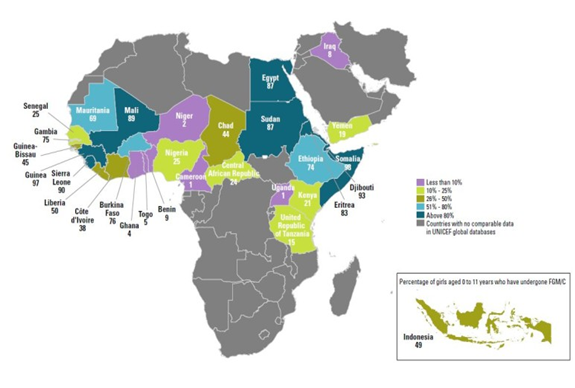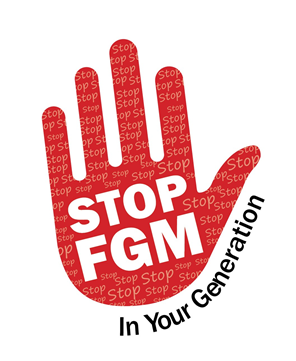
“The practice [of female genital mutilation] also violates a person's rights to health, security and physical integrity, the right to be free from torture and cruel, inhuman or degrading treatment, and the right to life when the procedure results in death.”
-World Health Organization-
ㅡ
At least 200 million girls and women alive today living in 31 countries have undergone FGM. An estimated 3 million girls are at risk of undergoing FGM every year.
ㅡ
Female genital mutilation refers to any procedure that involves partial or total damage to the external female genitalia or another injury to the female genital organs for non-medical reasons, usually carried out as a religious or traditional custom. The official name set by the World Health Organization (WHO) is “female genital mutilation” and is abbreviated as “FGM”.
According to UN data, there are at least 200 million girls and women alive today who have undergone FGM, and an estimated 3 million girls are at risk of undergoing FGM every year.
FGM is carried out mostly in about 31 countries in Africa, the Middle East, and Asia. It is estimated that 98% of women in Somalia, 97% in Guinea, 90% in Sierra Leone, 87% in Egypt, 83% in Eritrea, 74% in Ethiopia, 25% in Nigeria, 19% in Yemen, and 8% in Iraq were circumcised.
Recently, FGM has been introduced to Europe and American countries, as ethnic groups with FGM traditions have immigrated to Europe, United States, and South America.

Source: FGM Prevalence UNICEF (2016)
ㅡ
A 4,000-year-old practice – is it tradition or violence?
ㅡ
FGM is seen as a practice that has been handed down from generation to generation in Africa for thousands of years. Although the exact origin is unknown, there are several conjectures.
Three conjectures of the origin of FGM
① It has been performed for disease prevention, healthy sex life after marriage, and hygienic reasons.
② It started as a form of sacrifice to a fertility god.
③ It began as a rite of passage to becoming an adult or becoming an official member of a tribe or nation.

Reasons FGM is carried out
① Rite of passage to become an adult: Some societies believe that the clitoral gland of the female genitals are considered traces of men remaining in the female body, so women have to go through the FGM to become complete adults.
② Premarital purity: Some societies believe that girls who go through FGM are more likely to keep their premarital purity and become virtuous women after marriage. In this regard, there is a perception that women who have not been circumcised are unreliable and unsophisticated.
③ Polygamic reasons: FGM is practiced mainly in African and Islamic cultures, where polygamy is common. It is said that since it is not easy for a husband to take care of several wives at once under polygamy, he conducts FGM as a method to manage his wives
Girls and women who have undergone FGM have to live with physical side effects and complications throughout the rest of their lives. The procedure is accompanied by severe pain and bleeding. Most of the time, it is carried out without anesthesia. Furthermore, such pain can become a mental trauma causing the person to feel shame, loss, discouragement, and emotional anxiety for the rest of the person’s life.
By 2050, one-third of the world’s female population will be born in the 31 countries where FGM is still performed. This means that more than 500 million women will be exposed to the risk of FGM. In Somalia, where the proportion of women who experience FGM is high, the female population is estimated to double in 2050 compared to 2017, signifying that even more women will be affected by FGM.
ㅡ
Bringing FGM to the world’s attention
ㅡ

FGM was considered an African tradition until world-famous fashion model Waris Dirie, who had undergone FGM as a young girl growing up in Somalia, exposed its inhumane violence to Western society in 1997.
Waris Dirie served as the United Nations Goodwill Ambassador for the Elimination of Female Genital Mutilation from 1997 to 2003. During her tenure, she highlighted FGM as the most representative and symbolic international problem that suppresses women’s human rights.
International efforts to eliminate FGM
In 2003, the first lady of Nigeria, Mrs. Stella Obasanjo, officially declared “Zero Tolerance to FGM” in Africa during a conference organized by the Inter-African Committee on Traditional Practices Affecting the Health of Women and Children.
Then in 2012, the UN General Assembly designated February 6th as the International Day of Zero Tolerance for Female Genital Mutilation. Centering on the UN, many international organizations are working to spread the awareness that FGM is not simply a matter of culture or tradition but inhumane violence and are taking the lead in efforts to legally ban FGM. To eliminate FGM, women’s perception and understanding are more important than anything else. International NGOs have carried out education to change the perception of FGM from a beautiful tradition to a cruel and violent act against human rights.
The UN is carrying out various activities with the goal of eliminating FGM by 2030. Sustainable Development Goal (SDG) 5 is to “achieve gender equality and empower all women and girls.” The third target under this SDG is to “eliminate all harmful practices, such as child, early and forced marriage, and female genital mutilations.”
In July 2003, government representatives from the AU member countries gathered in Maputo, Mozambique, and adopted the Protocol to the African Charter on Human and Peoples’ Rights on the Rights of Women in Africa, or the Maputo Protocol. Article 5 of the Maputo Protocol emphasizes the elimination of harmful practices, referring to a ban on female genital mutilation and other traditional practices that are harmful to women.
Global media coverage and interviews of those who have undergone FGM have raised the interest of many people about the issue of FGM. UNICEF, Desert Flower Foundation, and Tostan are some of the international NGOs working to eliminate FGM.
Since the 2000s, many countries have enacted legal bans on FGM, and there has been the constant declaration of eradication of FGM led by community leaders. However, FGM has not been completely eradicated. Stay-at-home restrictions due to COVID-19 have worsened the situation.
ㅡ
Stop FGM!
ㅡ

In a world where diverse peoples and cultures actively interact and coexist, FGM is a common problem for the world. Living in the 21st century, we need to be aware of the violence of FGM that threatens girls' and women’s lives and work together to eliminate it.

